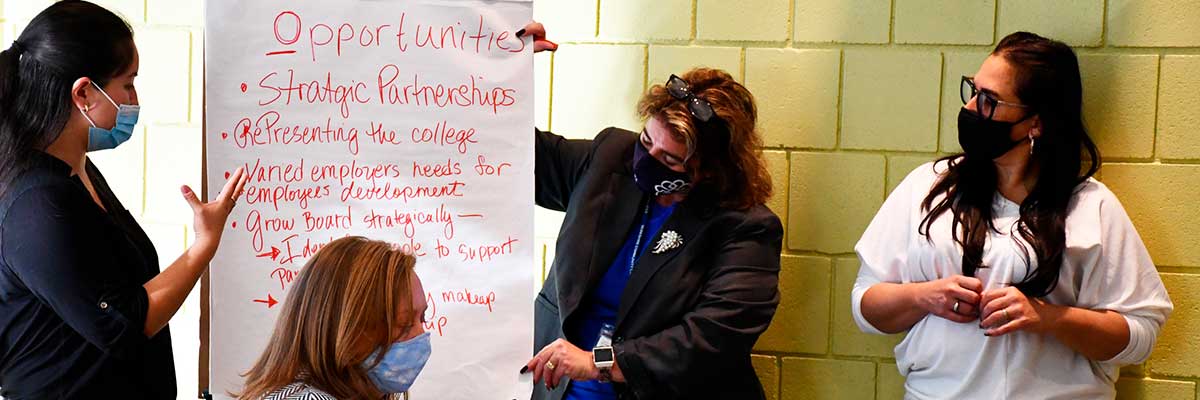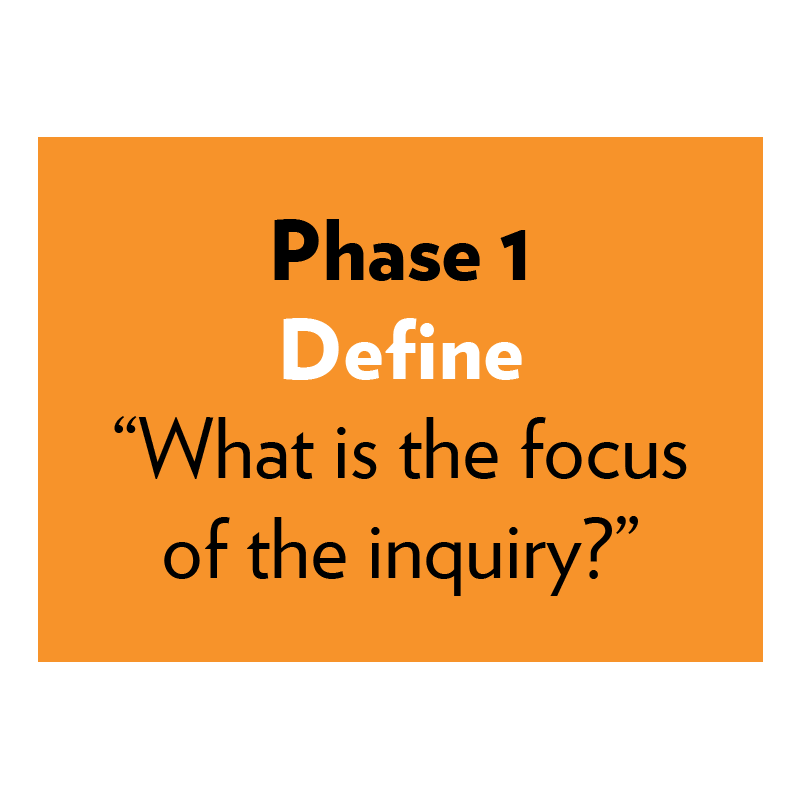Home Phase 1 – Define Phase 2 – Discovery Phase 3 – Dream Phase 4 – Design Phase 5 – Deliver

Phase 1 – Define
What is Strategic Planning at BCC?
Through community and campus-wide engagement using Appreciative Inquiry (AI), BCC began defining its 2022 – 2027 Strategic Plan (PDF).
What is Appreciative Inquiry?
Appreciative Inquiry (AI) is a strengths-based approach to development and organizational change.
AI can be used by individuals, teams, organizations, or at the societal level; in each case, it helps people move toward a shared vision for the future by engaging others in strategic innovation (CITE).

Caption: Phase 1 – Define, What is the focus of the inquiry?
BCC's Strategic Planning Kickoff, 2021
With Carlos E. Santiago, Commissioner of the Massachusetts Department of Higher Education
Massachusetts Department of Higher Education (DHE) Campus Strategic Planning Guidelines
Download DHE Strategic Planning Guidelines (PDF)
-
Message from Commissioner
Dear Colleagues,
This year we begin our second cycle of developing campus strategic plans in collaboration with the Strategic Planning Committee of the Board of Higher Education. Our touch points process and evolving guidelines are carefully aligned to the changing landscape in public higher education. As we strategically grow this system in the Commonwealth of Massachusetts it continues to be essential that we recognize both our calibrated effort to work as a whole, even as we differentiate the uniqueness of our institutions and the significance to the regions where they reside. I say this while further acknowledging that the faculty and staff members that teach and guide our students within each institution make an important difference in their success. Thus, when you set out to develop the strategic pathway for your campus over the next five years, it is your leadership as well as the full participation of all members of your campus community and the members of the Strategic Planning Committee, that is vital to ensuring the right strategic plan to guide your institutions and our students into future success.
The Board of Higher Education (BHE) staff and I wish to support your efforts in every way we can. The BHE has further revised its' guidelines beginning this year, to ensure that Massachusetts' public institutions are working together even more closely toward the best outcomes for public education across the state. Adding some performance metrics to the guidelines, which have been developed over time in a coordinated way with campus leaders, will enable us to be responsive to the needs of the Commonwealth in an alert and timely manner. This Campus Strategic Planning Handbook has been prepared to help us continue working in the coordinated and intentional way we have so carefully established. The calibration of campus and student needs with our statewide research, planning and strategic direction bodes well for the future of public higher education in Massachusetts.
Let our journey be productive and inspiring as we learn together, create improved student success rates, and provide high quality academic opportunities and learning experiences that are strategic and responsive to the needs of Massachusetts' citizens and communities.
Sincerely,
Carlos E. Santiago
Commissioner -
Introduction
A fundamental responsibility of the Board of Higher Education (BHE) is to provide overall direction to the Massachusetts system of public higher education. The Board enacts this responsibility by establishing statewide goals and regularly measuring and reporting progress toward these goals. Review and approval of campus strategic plans is another important aspect of this role. The BHE uses its review of campus strategic plans to inform its own system-wide efforts and to support campuses as they set their own strategic directions. The BHE will be guided in this endeavor by the BHE Campus Strategic Planning Committee (SPC).
Chapter 15, Section 7 of MGL states that the Secretary of Education will, in consultation with the council (BHE) "…have the authority to approve, reject, or propose amendments to said plan." New strategic plans should satisfy the requirements of both the Department of Higher Education (DHE) and the Executive Office of Education (EOE), to avoid sending mixed signals or duplicating effort. They should also be sufficient for DHE/BHE approval of "Partnership Plans" that govern special-purpose campuses with tuition retention authority. Partnership plan proposals shall include performance standards specific to the mission of the institution, and to the extent possible they should be aligned with the performance measurement system in effect across the public system.
While current system-wide goals build upon those of the past, college-level plans can be strengthened by expanding their scope beyond addressing current goals, to include a fuller consideration of strategic opportunities, challenges, and choices, as well as the institution's underlying business model. New plans should serve not only as a roadmap for an individual campus, but as part of a coherent plan for the higher education system as a whole – at both a regional and statewide level. In addition, such plans should provide a reliable and sufficient basis for guiding the BHE and staff in evaluating the strategic purpose of any new program proposals.
-
Guiding Principles and Criteria for Review
The BHE recognizes that each campus has its own unique mission, culture and community and that it is situated in a specific region. To support autonomy and individuality, campus strategic plans should reflect these unique characteristics. In addition, each individual campus plan must also be reflective to the statewide goals for public higher education in Massachusetts. The following principles guide the BHE's criteria for reviewing campus strategic plans:
- Be true to mission. Each campus should select a planning process that works best for its' unique mission, culture, community, and region.
- Focus on goals. Each campus should determine how to best align their strategic plans with system-wide goals, and to organize their work and resources to achieve strategic objectives. When relevant, metrics from the performance measurement reporting system should be incorporated in the measurement plans for tracking progress toward goal completion.
- Address statewide strategy: Each campus should provide evidence of how it will address the equity agenda for public higher education in Massachusetts with attention to short- and long- term student success.
The BHE will review campus strategic plans based on the following four criteria: campus planning process; goals; strategies; and metrics.
A. THE CAMPUS PLANNING PROCESS
The planning process should be transparent and inclusive. "Planning and evaluation are systemic, comprehensive, broad-based, integrated, and appropriate to the institution. They involve the participation of individuals and groups responsible for the achievement of institutional purposes and external perspectives…" (NECHE Standard 2.1).
The planning process should be a vehicle for cultivating a commitment from all members of the campus community, allowing institutions to grow, change and adapt practices as needed to achieve their goals.
B. GOALS
The plan should explicitly address the system goal of EQUITY, including college participation, college completion, and closing gaps. The BHE's specific embrace of the equity agenda is expected to result in continuing improvement in performance outcomes. The hard work of disaggregating data and identifying where barriers to success exist for specific populations will be significant to successful planning. Other elements previously incorporated such as student learning outcomes, workforce alignment, and preparing citizens can also be addressed. The plan should also be aligned with regional economic and workforce development priorities and include close consultation with other public institutions in the region to ensure strategic alignment, program integration, and cost-effectiveness, while closing gaps and increasing completion rates. Plans should include initiatives to deepen integration with local P-12 districts, including vocational-technical schools and identify opportunities for innovation. In addition, plans should provide a sufficient framework for new programs that BHE will be asked to consider for approval, as well as highlight areas of strategic divestment (i.e. what programs or elements a campus expects will sunset during this period).
- Campus goals. In the early phase of planning, campuses should take the opportunity to define their individual benchmarks and goals clearly in the context of the overarching system strategy focused on equity. BHE's strategic plan review will focus on system-wide goals even as BHE recognizes that campus strategic plans will include areas of focus, such as financial goals and benchmarks that are clearly defined and specific to a campus' unique identity. The BHE will look for goals to be reflective of where the campus is situated among peer institutions. The BHE is particularly interested in understanding enrollment estimates and projections as they relate to the strategic plan as well as the array of programs a campus may be planning to develop. Enrollment projections should include metrics reflective of the population pipeline, the Commonwealth's employment needs, and the campus expected capacity for traditional as well as on-line and competency-based learning.
- Changes in system-wide goals. The BHE may decide to amend or extend the system-wide goals to be included in campus strategic plans, but such changes will not require campuses to modify plans previously approved by the BHE. Rather, the BHE will discuss with campus leaders how the modified statewide goals can most reasonably be advanced within the framework of the current plan or in the next strategic planning cycle. The evolution of the Performance Measurement Reporting System helps the individual campus strategic goals and benchmarks to be understood in each campus context. The BHE expects that a Partnership Plan2 aligns with the system-wide goals with specific performance standards relevant to the mission of the institution.
C. Strategies
The most pressing challenge for both community colleges and state universities is the need to close persistent opportunity and achievement gaps that are tracked by race, socioeconomic status and gender. At both the community colleges and state universities, some metrics reveal progress for all racial/ethnic subgroups but no narrowing of gaps between white students and students of color, while others show worsening patterns with respect to both gaps and outcomes for students of color. The DHE will continue to monitor these trends to ensure new interventions and redesign efforts serve as a mechanism to improve success rates for students of color and not only white students.
The campus strategic plan should provide "…realistic analyses of internal and external opportunities and constraints…" (NECHE Standard 2.3) to achieve its' goals. The BHE will specifically review plans with regard to the strategies and programs that each campus uses to achieve specific institutional objectives and do so in the context of the statewide equity agenda. The Board does seek to understand that a campus has a plausible theory of action and operational business plan underlying its proposed strategy.
D. METRICS
To the maximum extent possible, the plan should include clear measures for evaluating progress on strategic planning goals over the course of the plan's duration, including both qualitative and quantitative methods (NECHE Standards 2.6, 2.7, 2.8). The measurement plans should incorporate metrics from the Performance Measurement Reporting System (see Attachment A) when relevant. It is expected that all strategic plans will incorporate the student success metrics focused on first year progress and long-term success.
Campuses may also devise public data dashboards that can be used by college boards (and others) to evaluate progress over time.
Touch Point II (details below) will include an informed dialog between the campus and members of the SPC. The measurements plans will be reviewed for use of the PMRS metrics to monitor progress. The Student Success metrics in the context of each institution will provide a focus for the SPC. This should enable deeper understandings around factors that influence the metrics as well as their implications for the campus plan
The Partnership Plan for special mission institutions must include budget and enrollment projections for each year, projections for total student charges for each year, projections for in-state and out-of-state enrollments for each year, and plans to ensure continuing access to the institution by residents of the commonwealth and affirmative action policies and programs that affirm the need for and a commitment to maintaining and increasing access for underrepresented students.
